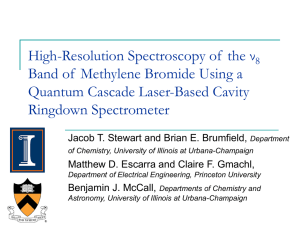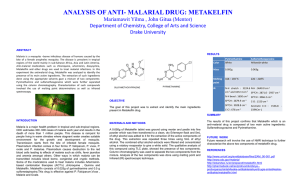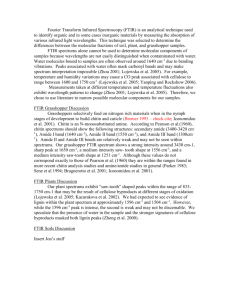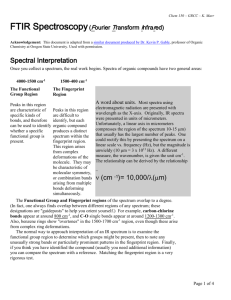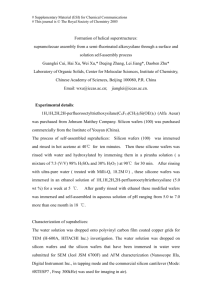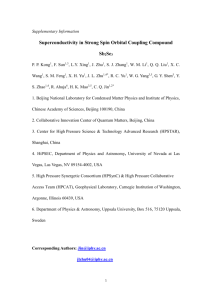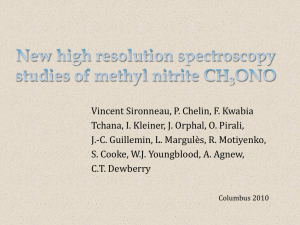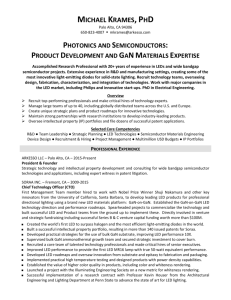Appendix: Model for emission from the C 2 H 6 recombination
advertisement
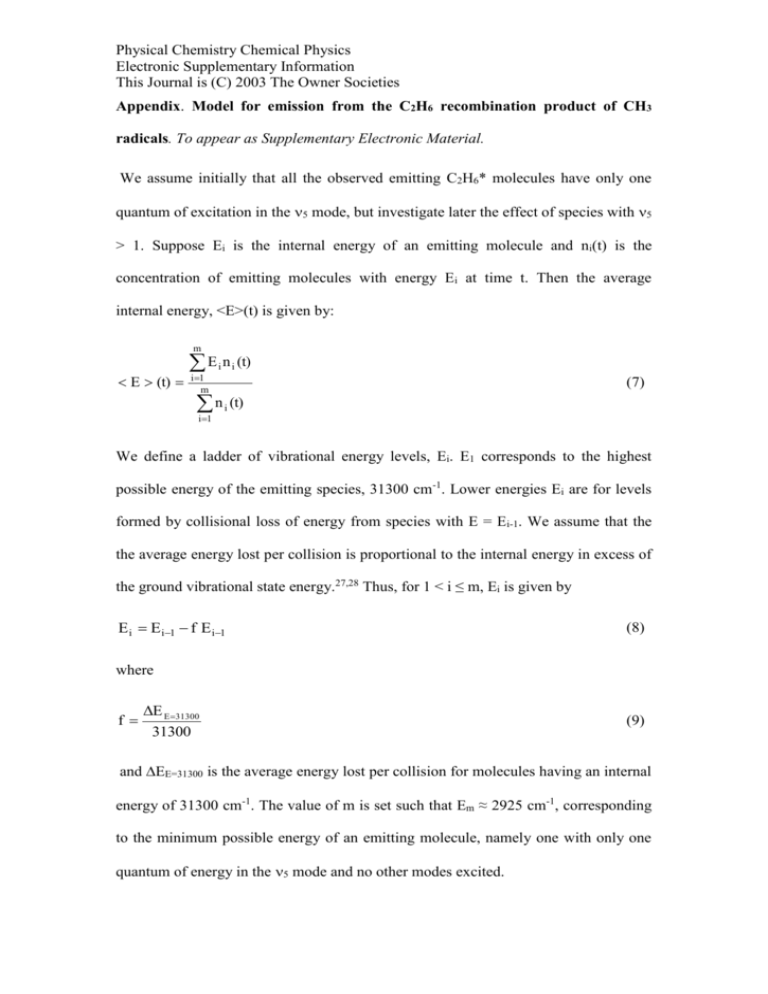
Physical Chemistry Chemical Physics Electronic Supplementary Information This Journal is (C) 2003 The Owner Societies Appendix. Model for emission from the C2H6 recombination product of CH3 radicals. To appear as Supplementary Electronic Material. We assume initially that all the observed emitting C2H6* molecules have only one quantum of excitation in the 5 mode, but investigate later the effect of species with 5 > 1. Suppose Ei is the internal energy of an emitting molecule and ni(t) is the concentration of emitting molecules with energy Ei at time t. Then the average internal energy, <E>(t) is given by: m E (t) E i n i (t) i 1 m n i (t) (7) i 1 We define a ladder of vibrational energy levels, Ei. E1 corresponds to the highest possible energy of the emitting species, 31300 cm-1. Lower energies Ei are for levels formed by collisional loss of energy from species with E = Ei-1. We assume that the the average energy lost per collision is proportional to the internal energy in excess of the ground vibrational state energy.27,28 Thus, for 1 < i ≤ m, Ei is given by E i E i1 f E i1 (8) where f ΔE E31300 31300 (9) and EE=31300 is the average energy lost per collision for molecules having an internal energy of 31300 cm-1. The value of m is set such that Em ≈ 2925 cm-1, corresponding to the minimum possible energy of an emitting molecule, namely one with only one quantum of energy in the 5 mode and no other modes excited. Physical Chemistry Chemical Physics Electronic Supplementary Information This Journal is (C) 2003 The Owner Societies The time evolution of the concentrations, ni, is described by the following rate equations. d[CH 3 ] 2k 3 [CH 3 ]2 dt (10) dn 1 k 3 [CH 3 ]2 k c [M]n 1 k 4 [M]n 1 dt (11) For 1 < i ≤ m, dn i k c [M]n i-1 k c [M]n i k 4 [M]n i dt (12) Here, k3 is the pressure-dependent recombination rate constant. The concentration of the nascent recombination product is given by n1 and this species has an internal energy of 31300 cm-1. It is removed by collisions at a rate kc[M] where kc is the gas kinetic collision rate constant and [M] is the concentration of the bath gas. The energy removed in such a collision is relatively small and corresponds to the energy gap between E1 and E2. The product of this process is therefore an emitting molecule of energy E2. There is a second removal process for n1, occurring at a rate k4[M] where k4 is the rate constant for the mode-specific removal of one quantum of energy from the 5 mode. Since we have assumed that all the emitting species have only one quantum of energy in the 5 mode, the product of this process will be a non-emitting species, so it will not appear further down in the energy ladder. Thus the formation rate of a species with energy Ei in the range E1 < Ei ≤ Em is simply given by the Physical Chemistry Chemical Physics Electronic Supplementary Information This Journal is (C) 2003 The Owner Societies product of the collision rate, kc[M], and the concentration of emitting molecules with energy Ei-1. The loss rate is analogous to the loss rate of n1. Equations (10)–(12) were solved numerically by the fourth order Runge-Kutta method of numerical integration. Time dependent values of ni thus obtained were used to calculate <E>(t) via equation (7). The model was run using input parameters corresponding to a system with 5 % photolysis of 100 mTorr acetone, with and without 8.2 Torr of Ar. The parameters are given in Table 1 Table 1: Input parameters for the model k3/ cm3 molecule-1 s- Case 1: 100 mTorr Case 2: 100 mTorr acetone and acetone 8.2 Torr Ar 3.110-11 4.2 × 10-11 5.010-10 3.010-10 310-11 310-11 (acetone), 310-13 (Ar) 800 200 1 kc/ cm3 molecule-1 s1 k4/ cm3 molecule-1 s1 EE=31300/ cm-1 Values of k3 and k4 are taken from fits to experimental data of the kinetic model described earlier (equations (2)-(4)). The collision rate constant, kc, was estimated from simple collision theory, with Lennard-Jones collision diameters of = 4.4 Å, 3.5 Å and 5.7 Å for ethane, argon and acetone respectively. There are no reported values for the average energy transferred per collision of vibrationally excited ethane with bath gas molecules. We have therefore adopted values which are of similar magnitudes to those reported for other systems in the literature. For example, Barker and co-workers27 used infrared emission to investigate the collisional deactivation of Physical Chemistry Chemical Physics Electronic Supplementary Information This Journal is (C) 2003 The Owner Societies highly vibrationally excited azulene. This was prepared with internal energies of 17500 cm-1 and 30600 cm-1 by laser excitation at 600 nm and 337 nm respectively, followed by rapid internal conversion from the S1(600nm) and S2(337 nm) electronic states to high vibrational levels of the S0 electronic ground state. The average energy transferred per collision was reported for eighteen different colliding partners. Typical values were 215 cm-1 (Ar) and 1234 cm-1 (C4H10) at 30600 cm-1, and we suggest that values of 200 cm-1(Ar) and 800 cm-1(acetone) are reasonable guesses for the average energy transferred in collisions of C2H6 (E = 31300cm-1) with Ar and acetone. The results of the model show that after a short induction period <E> reaches steady state values of 21000cm-1 and 14000 cm-1 for Cases 1 and 2 respectively, and the discussion above indicates that this is consistent with the observed invariance of the C2H6 emission spectrum with time. In the model above it is assumed that all the emitting molecules have only one quantum in ν5. Calculations of the densities of states of C2H6 (E = 31300 cm-1) show that this is true for 78% of the molecules with excitation in ν5, with virtually all the remainder (20%) having two quanta in 5. The model was modified to incorporate C2H6(5 = 2) and the resulting plot of <E> vs t showed the same trend as before, with a slightly lower steady state value of <E>. Higher levels of excitation in the 5 mode are therefore not expected to result in a spectral shift with time.

